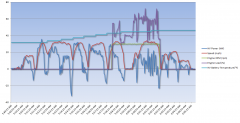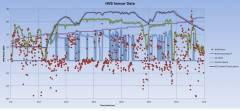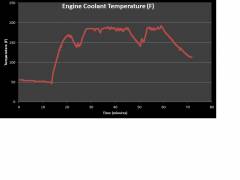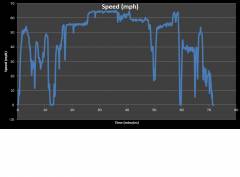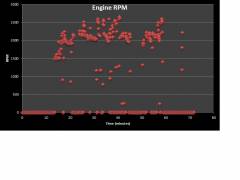

larryh
Fusion Energi Member-
Posts
1,462 -
Joined
-
Last visited
-
Days Won
152
Content Type
Gallery
Profiles
Forums
Everything posted by larryh
-
You have a short commute, so if the ICE turns on, it is going to be on for most of the commute. How much gas did it consume? I am usually able to get by with about 0.07 gallons.
-
An interesting calculation based on the plot above is to determine the efficiency of regenerative braking. At about 5:24:23 until 5:54:33 am, I applied the brakes for a stoplight. The initial speed was 44.1 mph and the minimum speed was about 16.2 mph. Assuming a curb weight of 3900 lbs plus another 200 lbs for the vehicle contents and the ice and snow covering the car, this represents a change in kinetic energy of about 0.087 kWh. The area above the negative part of the curve for HVB power during regenerative braking is approximately 0.081 kWh. This very rough calculation gives the generator an efficiency of approximately 0.081/.087 = 93%. Of course not all of this energy is stored in the HVB and you can’t get it all back. The SOC of the HVB went up 0.86% during this interval. So if 7.6 kWh is 100%, then it went up by about 0.065 kWh. That means about 80% of the energy was captured by the battery. Note that the battery was still cold at this point 37.4 F, so it probably won’t charge very efficiently.
-
I tried remote start for 10 minutes with the car plugged in this morning to see if that affected the HVB battery temperature. The temperature of the HVB remained at 30.2 F. Preconditioning warmed up the HVB the usual 4 degrees F.
-
The following is data from the OBD II sensors for my 8 mile commute to work when the outside temperature was -12 F. The units for HVB power are kW. The maximum speed was about 50 mph. When the ICE was on, the rpm was about 1500 rpm. The engine load is percentage. HVB temperature is degrees Fahrenheit. The HVB warmed up from 32 F to 46.4 F during the trip. You can see regenerative braking taking place when I slow down--the HVB power is negative indicating power is being applied to the HVB to charge it up. The ICE came on at about 5:58 am indicated by the green curve. Rpms were 0 until that time. While the ICE was on, you can see the power supplied by the HVB was reduced. It looks like the HVB and ICE shared the load equally. You can observe that on the Engage display showing the power supplied by the ICE and by the electric motor being about equal. The ICE could be applying power directly to the wheels, or it could be running the generator to supply more electricity for the electric motor. Most likely, it is a combination of both. It is unclear exactly how they are sharing the load--I'm not sure how to determine that. You can see the load on the ICE fluctuate with speed. During regenerative braking, the load is about 30%. At idle, it is about 40%. And a 50 mph, it is about 60%. While the ICE was on, I kept slowing down to see if I could get it turn off. That is why the HVB power fluctuates from 6:01 to 6:02. Note that when I am stopped at a stop light at around 5:59 am, the HVB power is 0. That implies the ICE is powering the generator to exactly match the power requirements for the car.
-
From the album: Car
OBD II data for 8 mile commute to work at -12 F. -
I observed the car continuing to draw about 67 watts of power today from the charger after charging the HVB completed. I was able to verify that the 12 V voltage was 14.8 V. So, sometimes, after charging is completed, the car continues to draw power from the charger to charge the 12 V battery. This occur approximately every 2 weeks.
-
They modified the software for the Fusion Hybrid recently to change the algorithm for the active grille shutters along with several other software updates for improved gas mileage. However, I am not aware of any updates for the Energi. http://www.fordfusionenergiforum.com/topic/1143-ford-hybrid-software-update-will-improve-gas-mileage-arrives-in-august/?p=5862
-
I see in the owners manual regarding the left display: Coolant Temp – Indicates engine coolant temperature. At normal operating temperature, the level indicator will be white and will be in the normal range (between “H” and “C”). If the engine coolant temperature exceeds the normal range, the level indicator will change to red to indicate that the engine is overheating. Stop the vehicle as soon as safely possible, turn off the vehicle and let the engine cool. The thermometer indicator next to the gauge will illuminate in blue or white to indicate the following: Blue thermometer - This indicates that the hybrid system is not warm enough to allow EV operation. The gasoline engine will run continuously when the indicator is blue. During silent key start mode, the thermometer indicator will be blue, but the gasoline engine will not run. This is the result of the vehicle computer allowing the engine to be cooler during the silent key start period. This is normal operation and does not indicate a problem with your vehicle. After the first engine start the indicator will turn white when the gasoline engine is warm enough to turn off. White thermometer - This indicates that the hybrid system is warm enough to allow EV operation. If the vehicle operates on battery power long enough, it is possible that the gasoline engine may need to run to keep the system warm. In this case, the thermometer indicator will revert back to blue.On my return trip home this afternoon, the thermometer was always white, even when the EV icon was yellow, and later, after EV Now and EV Later modes of operation were disabled. So this does not appear to be implemented correctly. I wonder if silent key start mode is what they were referring to in the previous post regarding overriding normal priorities to run in EV mode when starting out from a frequent destination and the mode is set to EV Now.
-
Yes, I think the engineers are referring to cooling the engine compartment. The components in the engine compartment cool much faster when driving with the wind blowing through the grille.
-
I asked Ashley regarding the ICE coming on in cold weather. I received the following reply. The ICE will come on in extreme cold temps to help with maintaining the battery pack temp. Once the vehicle is out of the garage and moving with the wind chill it will cool off the entire vehicle quickly. Using the block heater will help some with this concern similar to preconditioning the vehicle. It would then take longer before the ICE would have to engage. The vehicle starting cold at work in EV Now mode is because the vehicle is near one of its normal stopping destinations. It will prioritize EV mode when you are near a normal stopping destination more than when not near one. So once the vehicle is driven far enough away it determines you are not stopping and then goes to a different strategy depending on the needs of the vehicle. Unfortunately in very cold temperatures of 0 degrees Fahrenheit or colder the vehicle will need to use the ICE more.
-
The trip took 15 minutes. The ICE ran for 4:12 minutes, 8:42 minutes after the trip began. It ran at a constant 1500 rpm the entire time, even though speed varied from 0 to 50 mph. The ICE consumed an average of 0.0158 gallons/minute, or 0.066 gallons of gas. (I’ll have to see what happens if I use the EBH). The HVB temperature rose from 32 F to 46.4 F. The HVB SOC fell from 96.7% to 66.4%. The coolant temperature was 10.4 F when the ICE started, rose to 111.2 F, and then fell to 104 F. The generator inverter temperature rose from 26.6 F to 80.6 F (the ICE helped it significantly), and then fell to 66.2 F. The motor inverter temperature rose from 30.2 F to 87.8 F (again helped by the ICE) and then fell to 69.8 F. The ICE raised the catalyst temperature from 17.6 F to 1015.7 F. The ICE load was 48.8%. I’m not sure what that is. There are a lot of other parameters I could record, but I don’t know what they are and how relevant they are to determining the conditions under which the ICE starts.
-
The range on the battery was 20 miles this morning. So the battery has been colder in previous weeks. The ICE came on a little over half way through the commute. The HVB temperature was up to 46 F at the end of the 15 minute commute. I think when the ICE is warming up, it is applying very little torque to the wheels. Instead, it is running the generator to power the electric motor. The goal is to reduce emissions during warm-up. You will see the power levels in the Engage screen about equal for both the ICE and the electric motor.
-
It is 9 F in the garage this morning, -13 F outside. The car charged from 1:00 am to 3:00 am this morning using the 240 V charger. The HVB temperature after charging completed was 30.2 F. Preconditioning with the 240 V charger began around 4:50 am. The HVB temperature at that time was 28.4 F. Preconditioning finishes at 5:45 am. The HVB temperature is 32 F. It did not warm up significantly.
-
In order to observe the HVB sensor data, I have to turn the car on so that the scanner can connect to the ECU. When the car is turned, it generally uses about 1 amp of current from the HVB. So I assume that 3 amps were going into the HVB and 1 amp was being diverted to power the car. So that accounts for the all the power: 4 amps * 341.5 V = 1366 Watts, which is what I observe on the Kill-A-Watt meter.
-
I have not done anything with blocking the grille.
-
I combined the previous charts into one to make it easier to correlate events. The units (kW) along the vertical axis are only applicable to HVB Power, i.e. the red spherical markers. I didn’t put the units for the other sensor data on the chart. See the original plots above for their units. The HVB Power is positive if power is being extracted from the battery, e.g. to power the wheels, and negative if it is being added to the battery, e.g. regenerative braking. All data was taken at 5 second intervals, so there is a red spherical marker every 5 seconds indicating the HVB power at that time. Trip segments: 0 – 12 minutes: EV Now mode. This segment of the trip was at lower speeds through local towns. You can see the ICE coolant temperature slowly falling with the ICE off indicated by ICE RPMs equal to 0. When speed decreases, you can see significant negative HVB power from regen—almost 30 kW when braking. You can also see the HVB temperature gradually increasing. 12 – 45 minutes: Switching between EV Auto and EV Later modes. This segment is highway and then freeway (you can see speed increasing on the freeway). With the ICE running, the ICE coolant temperature quickly rises. You can also see that the ICE generates about 0 to 5 kW of power to charge the HVB. When the ICE turns off, the electric motor drains 10 – 20 kW of power from the battery. Also, coolant temperature drops rapidly, i.e. from 22 – 24 minutes. The HVB temperature rises more slowly, most of it occurs when in EV mode (when there are a bunch of red spheres above zero). 45 – 50 minutes: EV Auto mode. Long gradual descent to the Mississippi river. With the ICE off for 5 minutes, the ICE coolant temperature falls significantly. The electric heater for climate comes on. The HVB temperature rises a little faster in EV mode, but not as fast as the initial segment. Going downhill doesn’t require as much power. 50 – 58 minutes. Switching between EV Auto and EV Later modes. Now I am on the other side of the river going uphill. The ICE comes back on and warms up the coolant. Again, HVB temperature rises only when in EV mode. 58 – 70 minutes. EV Auto mode. I have now exited the freeway and driving in the city. The ICE is off for the most part. The ICE coolant temperature really drops. You can see a bunch of red spheres above 30 kW at about 66 minutes. I am accelerating up a hill trying to use up the remaining charge in the HVB. The HVB battery temperature rises at the fastest rate so far during the trip. I use a little too much power from the HVB and the ICE comes on briefly.
-
From the album: Car
HVB sensor data for a 60 mile commute. -
The EV range this morning was 23 miles. Last week it was around 18 miles. So the HVB must be warmer than normal from yesterday's drive. But that didn't affect the MPGe for this morning's commute. It was in line with previous trips. It will get a bit colder tonight, down to -14 F.
-
It is 30 F in the garage this morning. The car charged from 1:00 am to 3:00 am this morning using the 240 V charger. The HVB temperature after charging completed was 51.8 F. Preconditioning with the 240 V charger began at 5:10 am. The HVB temperature at that time was 50.0 F. Preconditioning finishes at 5:45 am. The HVB temperature is still 50.0 F.
-
This plot shows Engine Coolant Temperature for the 60 mile commute. You can see the temperature falling when the ICE is off. It falls off much faster when temps are colder than today's 36 F temperature. You can't leave the car in EV mode for too long before the heating element for climate controls turns on. Optimizing EV use in cold weather requires a different strategy than in the summer.
-
From the album: Car
This plot shows the Engine Coolant Temperature for the 60 mile commute. -
This chart shows the car's speed for the 60 mile commute to give an indication of the power demands on the HVB.
-
From the album: Car
This plot shows the car's speed for the 60 mile commute. -
The following chart shows the ICE RPM for the commute that can be used with the previous charts to determine when the ICE was on You can see when the car was in EV mode, i.e. RPM was 0.
-
From the album: Car
This plot shows the ICE RPM for a 60 mile commute.

